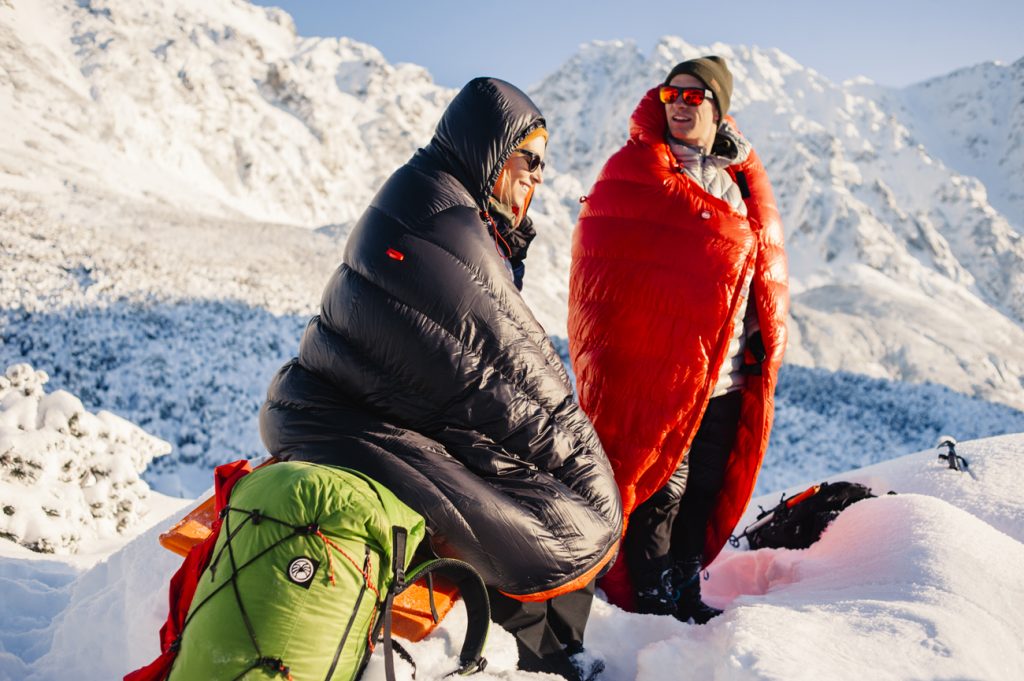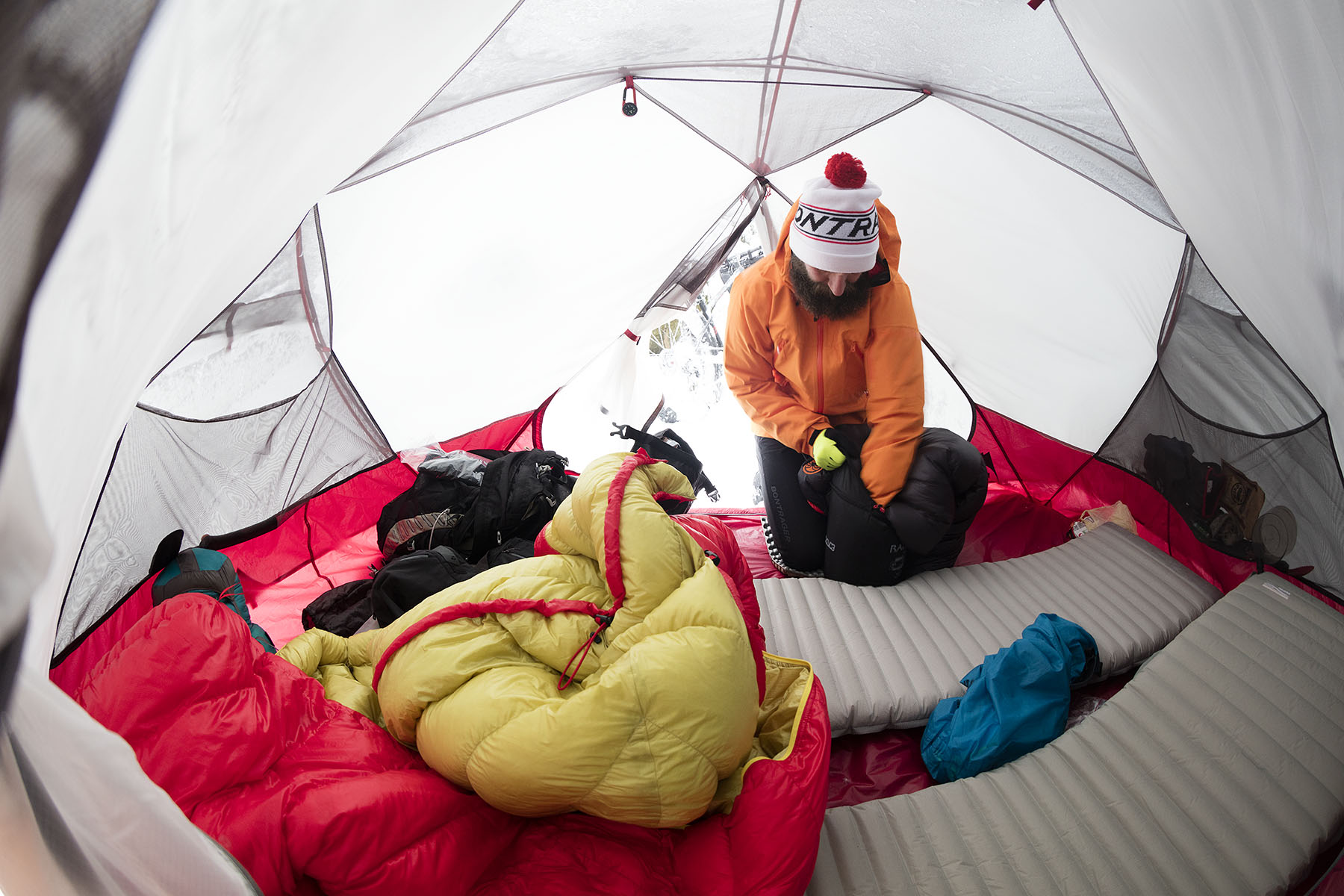
How to prepare for a winter night in a tent?
Winter camping in the mountains is a challenge for true tough guys. However, the reward for enduring difficult conditions is an unforgettable adventure that every outdoor lover should try at least once in their life. But it's important to prepare well before deciding to sleep in the mountains during winter. Here's what you need to know:
WHAT WILL YOU LEARN FROM THIS POST?
- What to bring for winter camping?
- What tent is suitable for winter camping in the mountains?
- What sleeping bag to choose for winter camping in the mountains?
- What to sleep in inside the tent during winter?
IN BRIEF
To survive a winter night in a tent during a mountain expedition, you need the right equipment. Choose a tent that sets up quickly and easily, with a frame that can withstand strong winds. Don't forget a self-inflating sleeping pad that provides insulation from the cold coming up through the tent floor and ensures comfort. Choose a down sleeping bag wisely, aiming for models with a high down-to-feather ratio and high loft. If you're concerned about getting a down sleeping bag wet, bring a simple synthetic summer sleeping bag that you can layer on top to protect yourself from water droplets.
Whether you're heading to the Himalayas or the Bieszczady Mountains, the mountains in winter will welcome you... coldly. You must prepare properly for this meeting, and there are no exceptions to this rule.
HOW TO DRESS IN THE MOUNTAINS DURING WINTER?
First and foremost, don't overdress. Although it may seem like wearing multiple layers is the perfect recipe for winter cold, the reality is quite the opposite. If you dress too warmly, you will overheat during the hike, and sweat will soak into your underwear. As soon as you stop, you will feel the piercing cold. Therefore, it's best to start the hike with fewer layers and allow your body to warm up during physical activity. It's always a good idea to have additional warm clothing in your backpack, such as a down sweater, to put on during breaks.
Having fewer layers doesn't mean wearing summer clothing! In winter mountains, you need to cover all parts of your body. So even if you're hiking in a lightweight jacket, you still need to wear a hat, neck gaiter, and gloves.
Take care of your feet as well. Warm socks, an additional insole, and sturdy waterproof boots with gaiters that prevent snow from getting inside will help you maintain comfort even when walking through deep snow.
However, keep in mind that the most important part to protect is your head. Your body will do everything it can to keep your head at the right temperature, even at the expense of frostbite on your fingers. Wear a hat, otherwise your feet won't warm up!
WINTER NIGHTS IN THE MOUNTAINS
WHAT EQUIPMENT IS SUITABLE FOR WINTER CAMPING?
The first important aspect is choosing the right tent. Let's not fool ourselves: the cheapest model from a discount store will not withstand the whims of winter weather. Your tent for a snowy bivouac should be constructed in such a way that neither a blizzard nor snowfall will harm it. An igloo-style design with a sturdy, freestanding frame that doesn't require excessive tension, a waterproof floor, and additional features like snow skirts, a low vestibule, and a high tent entrance are the criteria that make a tent suitable for winter camping. It's also important to ensure that setting it up is not a logistical challenge, it doesn't take long, and you don't have to remove your gloves.
Further difficult decisions are related to choosing a sleeping pad. It won't be a big revelation to say that during winter, it gets a bit chilly from the tent floor, right? That's why you need something that will serve as an effective insulator. A combination of a self-inflating sleeping pad (on top) + a foam mat (on the bottom) works well. This way, you'll have both warmth and comfort, giving you a chance to sleep peacefully throughout the night, and we all know that regeneration during sleep after a tiring hike is essential! An even better and lighter option would be an inflatable mattress with synthetic insulation inside.

THE MOST IMPORTANT ELEMENT OF CAMPING GEAR: SLEEPING BAG
You can't go into the mountains at night without a good sleeping bag. But what exactly makes a good winter sleeping bag? The answer is very simple: down. Despite scientists' efforts, they still haven't come up with a technology that can match natural down in terms of weight, loft, and insulation efficiency. The warmest down sleeping bags weigh no more than a sugar packet and can be compressed to the size of a cup. This magical trick is all thanks to Mother Nature herself, who gave goose down the extraordinary ability to trap still air between small, lightweight clusters. This trapped air acts as insulation, protecting you from the cold when you sleep in a down-filled sleeping bag. It doesn't take much down to create sufficient insulation. However, it must be high-quality down with excellent loft and a high down-to-feather ratio.
You can find sleeping bags that won't disappoint you in the mountains at pajaksport.pl. The Radical line, including the flagship product Radical 16H, was created specifically for winter expeditions. It is believed to be the warmest sleeping bag in the world, capable of withstanding temperatures down to -73 degrees Celsius, according to laboratory tests. The Radical line also includes options for less demanding winter mountaineers, such as the Radical 10Z, which can handle temperatures down to -31 degrees Celsius. Both models are filled with 900 FP white Polish goose down, highly regarded worldwide. As a result, they take up minimal space in your gear while providing a safe and peaceful sleep at night. Another notable feature of these sleeping bags is the internal IRR coating, which reflects the heat emitted by your body, further enhancing thermal comfort during sleep.
Experienced outdoor enthusiasts on short trips in moderate weather may find the Radical 4Z sufficient. Weighing just 730 grams (size L), it is a versatile all-season sleeping bag.
When choosing a sleeping bag, remember that it should be suitable for your height as it performs best when properly sized.
OR PERHAPS SYNTHETIC?
The only issue with using a down sleeping bag in the winter mountains is moisture. Natural insulation is exposed to moisture from the outside as well as from your own perspiration. But this can be easily addressed: if you layer a thin synthetic sleeping bag over the down sleeping bag, you shift the dew point and the natural insulation remains unaffected, retaining its irreplaceable insulating properties throughout your trip.
WHAT TO WEAR TO SLEEP?
Certainly not everything you have! In a good down sleeping bag, the less you wear, the better you'll sleep. A set of dry thermal underwear, socks, a hat or balaclava will suffice. Before getting into the sleeping bag, warm up by doing some physical exercises, but not intense enough to make you sweat.
How to survive a winter night in the mountains?
Equipment and gear are one thing, but once you've carried all that stuff to the summit, how do you actually make use of it?
Choosing the right campsite is important. First and foremost, it must be safe, away from cliffs, gullies, and any terrain features from which you or others could fall if a snow overhang collapses or an avalanche occurs. Secondly, the spot should be sheltered from the wind but not located in a deep depression where the temperature would be lower than on the surface. Additionally, it should be relatively flat (up to a 20-degree slope).
Before setting up your tent, use a shovel to uncover the ground beneath the snow, and if that's not possible, pack the snow down into a stable platform. However, keep in mind that using snow stakes won't be effective when tightening the tent's guy lines. Instead, use large objects that you can bury in the snow, such as skis, snowshoes, ice axes, or poles. You can also use heavy stones as anchor points if they are available in the chosen camping area.
If multiple people are sleeping in the tent, make sure the sleeping mats are placed side by side to prevent someone from ending up on the cold floor while tossing and turning at night.
During snowfall, do not allow snow to accumulate on the tent walls to avoid excessive stress on the tent fabric.

WHAT ELSE TO BRING?
You won't survive a winter mountain bivouac without a warm meal, so in addition to a mandatory thermos with a hot drink, don't forget to bring a stove and fuel canister. It's best to choose a stove with winter fuel that doesn't lose its properties in low temperatures. Keep in mind that cooking takes more time and consumes more fuel in winter, so it's advisable to rely on freeze-dried meals that only require the addition of the appropriate amount of boiling water to obtain a nutritious meal.
Don't forget about outdoor essentials: a headlamp (make sure to have spare batteries since they drain faster in the cold) and trekking poles (with snow baskets). If you want to warm up quickly, bring chemical hand warmers (remember not to place them directly on your hands as it's not very effective; a better option is to place them near your solar plexus or liver area). When the trails are buried in snow, a GPS device can be invaluable. Just remember that electronic devices sometimes malfunction in cold temperatures, so it's wise to have a traditional map and compass and the ability to use them.
If it's your first time going on a winter bivouac, opt for a familiar and well-known area. The best choice would be to camp near a mountain hut or shelter where you can evacuate if needed. Don't take unnecessary risks and don't hesitate to make a responsible decision if you or your expedition companion experience symptoms of hypothermia. We wish you a lot of satisfaction in taking on this challenge!
Check also:
Image source: pajaksport.pl